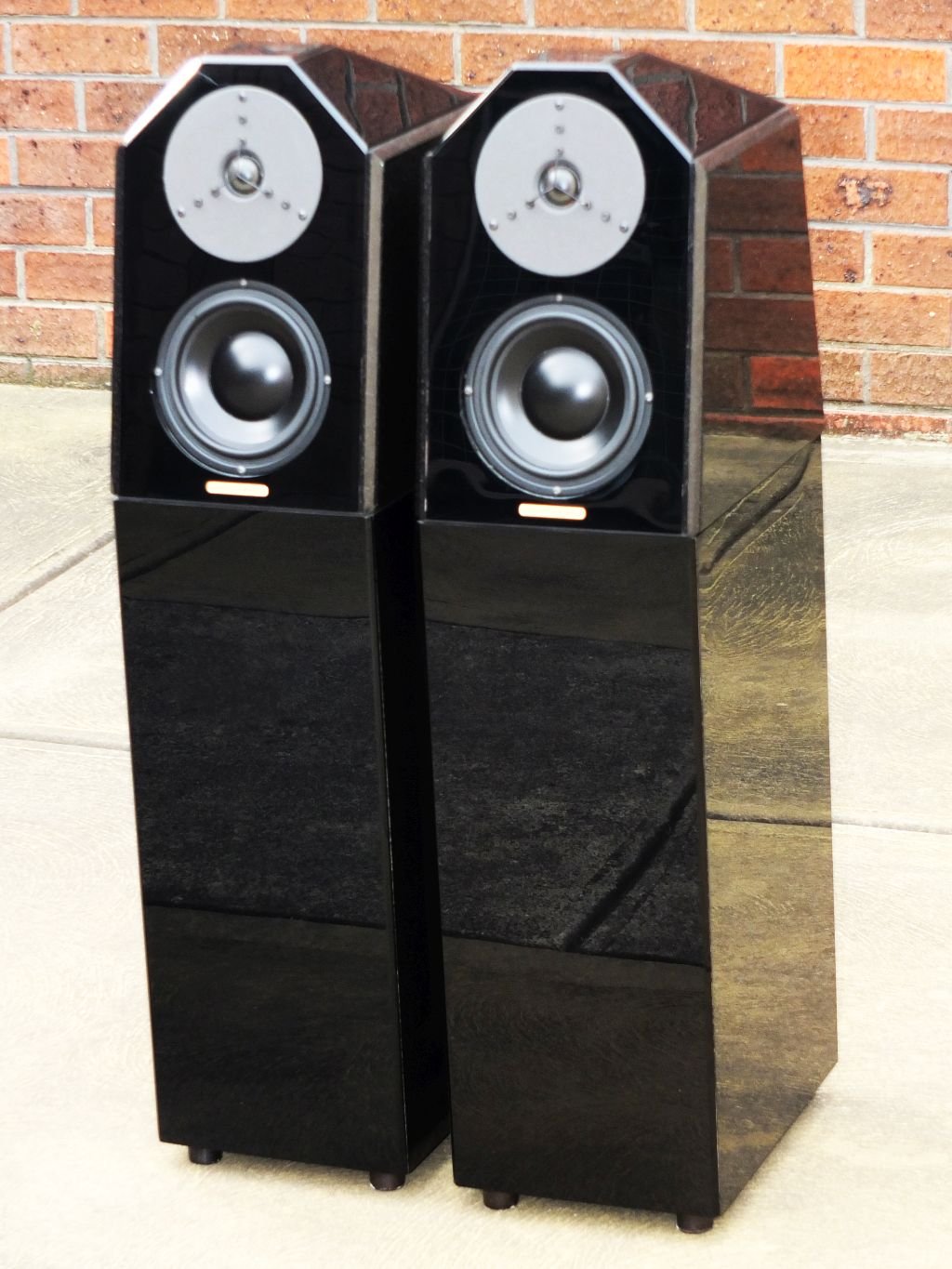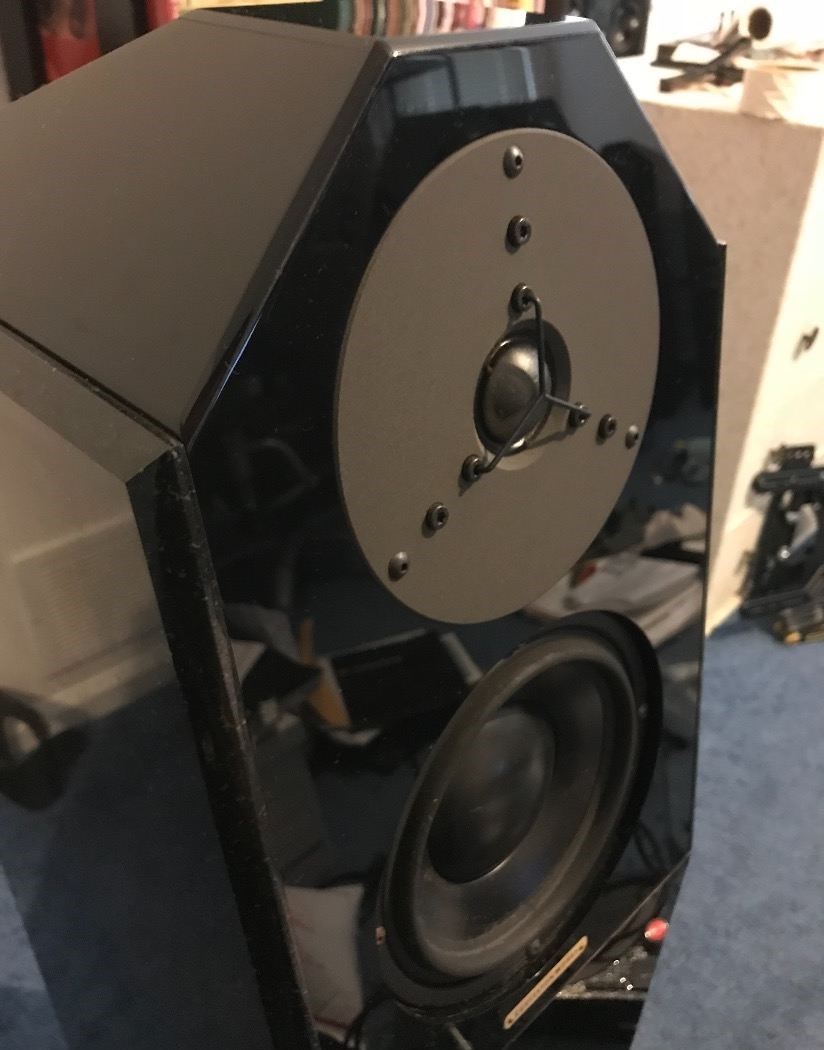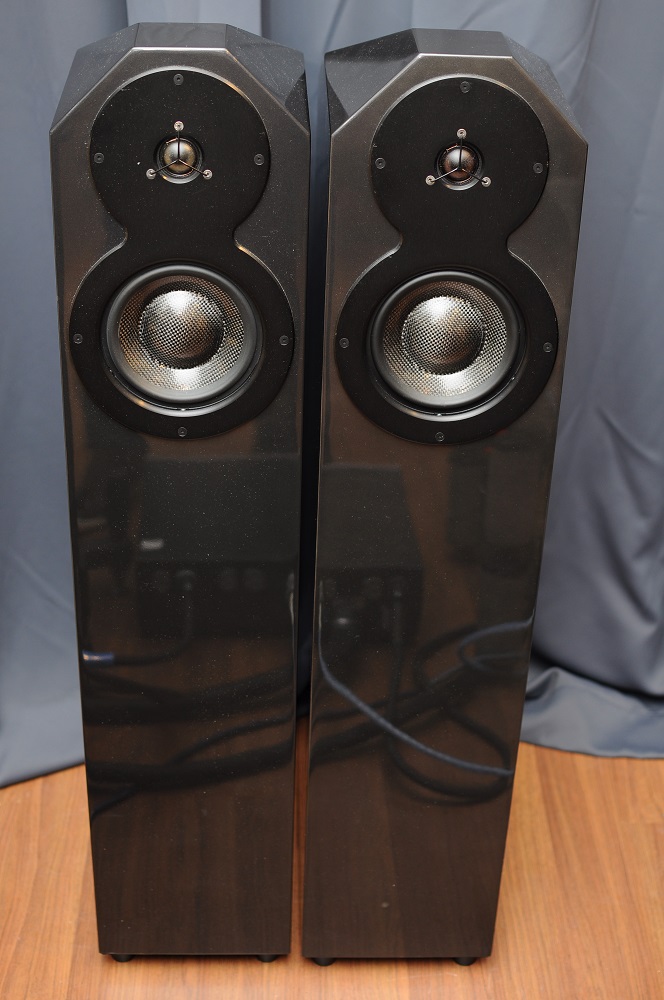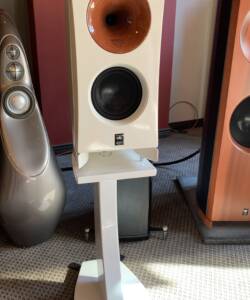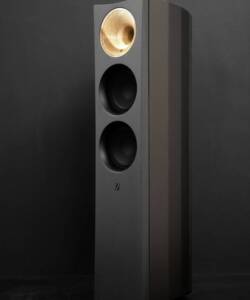Eggleston Works Isabel (Black Sparkle)
Original price was: R95,000.00.R24,000.00Current price is: R24,000.00.
EgglestonWorks Isabel Loudspeakers
by Jon Gale
Review Summary
|
We all have, to one extent or another, an audio “to do” list, a mental list of products we intend to seek out, evaluate, and experience. High on my list have always been the wares from EgglestonWorks. I happen to love the aesthetics of their products and, more importantly, have longed to hear the combination of drivers used in them. When word leaked from the SoundStage! offices that the Isabel was up for review, I failed to feign indifference. (Privately I’ll admit it was more along the lines of “gimme, gimme gimme!”)
Goodies galore
The Isabel is a gorgeous piece of work. Cabinet walls start as two layers of 5/8″ MDF adhered together with a vibration-damping material used in the floorboards of European trains. The front, rear, and beveled top surfaces are finished in a polished resin, requiring 16 (!) sanding and polishing tools. Finally, EgglestonWorks’ trademark Italian-granite side panels, 1/2″ thick for the Isabels, are mounted. The result is a very heavy, very inert, and very beautiful enclosure measuring 91/2″W x 13″D x 15″H and tipping the scales at 55 pounds.
The driver compliment consists of one 1″ cloth-dome tweeter with a large-diameter vent on its pole piece and a large aperiodic damping chamber that imitates infinite-baffle loading. This is the famed Dynaudio Esotar used in other speaker models, including those from EgglestonWorks, and known as being one of the costliest tweeters available. The Morel woofer is a 6″ polypropylene, double-magnet driver with a 3″ voice coil. This driver is run full range and loaded in a single aperiodic, vented box. The crossover point is 3.5k. Internal goodies include Transparent wire, Hovland Musicaps, and Vishay resistors. Claimed frequency response is from -3dB at 60Hz to well beyond 24kHz. Stated efficiency is 87dB, with an impedance of 8 ohms nominal, 6.3 ohms minimum.
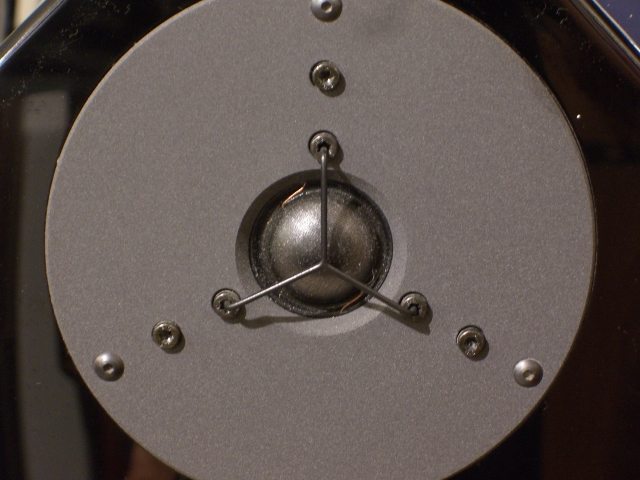
Finally, a word about the grilles, which are simply the finest I have (not) heard. While the mounting technique, a thin steel grille frame attached via magnets buried underneath the laminate, is not terribly unique, the grille material is. Quoted as “an extremely transparent material,” it looks like nylon to me, like women’s hosiery. The thinness of the steel frame should cause very little, if any, diffraction effects. This coupled with the acoustic transparency of the grille material makes for the first grille in my experience that has virtually no effect on the high frequencies. Very, very well done.
Stand assembly
Also available is an integral stand for the Isabel ($500 USD per pair). And what a beautifully designed and finished product this is! The stands share the Isabel’s outer dimensions (with a height of 23 3/4″) and stunning aesthetics; not purchasing the stands for the Isabel would be foolish savings. Made of 1″ MDF, the stand fastens to the Isabel via four bolts inserted through the inside top of the stand. Assembly is a relative snap when following the thorough and concise instructions. You simply lay the Isabel and stand on their sides and align the bottom of the Isabel to the top of the stand. Removing the screw-fastened oval cutout at the bottom of the stand allows access for the insertion of the four bolts for attachment. Everything aligned perfectly, and no expletives were necessary. Total assembly time was 20 minutes. Once stood on end and placed, there is a removable circular plug at cabinet rear to facilitate sand/lead shot filling.
The four supplied spikes per cabinet are some of the best I’ve seen. These large-diameter, threaded spikes are machined with a “straight” pipe thread, meaning many threads per inch, and have little or no slop in the threads. This fine pitch also allows for exacting height adjustments. After leveling, I ended up with the front spikes turned outward, raising the front of the cabinet, three full turns. One word of caution: As mentioned, there is very little slop, or play, in the threads, and the spike itself has very little “lead” at the beginning of the threads. Just be patient when first screwing these in or they could be stripped due to misalignment.
Set up
The Isabel proved to be decidedly easy to set up and dial in. With its claimed wide dispersion pattern, I was expecting an arduous chore ahead in taming boundary influences. In actuality, however, the Isabel taught this old audio dog a new trick or two.

After finding the proper location for best bass response in my room (4′ feet from front wall, 3′ from side walls, speakers spread 8′ apart, with a listening distance of 9-10′), I moved the side-wall absorption panels to the new reflection points. What I heard was exactly opposite from what is supposed to happen. When the reflection points are treated, what is usually perceived is a general smoothing of the midrange/treble frequency response. This is due to the untreated points causing comb-filter notches — steep, narrow suck-outs caused by cancellation. When treated, you will also gain an overall tightening of images. The overall “room response” with the Isabel now showed even more of a slight perceived upper-midrange dip. Or possibly, this dip was now exposed, as a bit more of the highs were absorbed. I decided to gradually remove the room treatment until only the corners were treated with Tube Traps, along with minimal side-wall absorption for first reflections. What resulted was a wonderfully smooth “power response,” or total room sound.
All this fussing about with acoustical treatment leads me to one conclusion: The Isabel seems to be very cannily voiced for real-world installations and rooms. With its wide dispersion pattern, it sounds like a great deal of thought was given to power response, not just on-axis linearity. Considering that the majority of the sound we hear when listening is composed mostly of room reflections, it is gratifying to see power response finally given its due. And what all this rambling means to the real-world audiophile is this: A speaker with an even power response will be far easier to set up in a given room, and it necessitates much less acoustical treatment to meet its performance parameters. The majority of audiophiles do not have a dedicated listening space, much less a properly treated room, but the Isabel is the closest thing to a “put it almost anywhere for good results” speaker I have heard.
Sound
With apologies to Oldsmobile, the Isabel is not your father’s two-way! Just close your eyes and think large. Sit within the surprisingly large sweet spot, and your ears will not believe the eyes: wall-to-wall image bloom with only a hint of speaker localization, and this hint only in a narrow frequency band of the tweeter. Now here is how to make a two-way monitor. The Isabel was surprising even during the initial break-in period. Using my preferred arsenal of break-in discs, which consists pretty much of the whole William Orbit catalog, the room-filling weight these diminutive speakers delivered consistently surprised me. Not only are these discs perfect for speaker/subwoofer break-in, for the unwary, they are perfect for breaking them period!
|
Thus, a big, bold, dynamic presentation is to be had with the Isabel. Bass performance (in my concrete room, a solid 40Hz was obtained) was as low as it goes — and tight, dynamic, and very resolved. More than one guest was convinced there was a downward-firing driver inside the matching stand! The bass was always tuneful, tight with no overhang, and dynamic. What the Isabel cannot do, it does not attempt. One of the highest compliments this admitted low-octave junkie can bestow upon a small monitor is that I never once had the notion of lashing the Isabels to my subwoofers.
It is in the midrange where things become a bit idiosyncratic. As with the previously reviewed Tyler Acoustics Mini Monitor, there is a shallow frequency-response trough in the upper midrange, especially when the speakers are listened to on-axis. Note this last qualifier, on-axis. While I did the bulk of my auditioning 10 to 15 degrees off-axis, this is not the whole story. Behind the scenes, we at SoundStage! have been actively pursuing blind testing and test data through the National Research Counsel of Canada. Also, we’ve conducted many hours of investigative questioning of manufacturers during visits to their facilities. What we are finding, which many of us intuitively knew all along, is a growing trend toward weighing the power response of a speaker a bit more heavily against traditional on-axis response. To over simplify, power response is the measurement of the overall energy delivered into the room, including all reflections, not just anechoic on-axis response. A wonderful at-home test is to listen to your system from another room. What you are hearing is the total sound power, on- and off-axis, including reflections.
The EgglestonWorks Isabel is a speaker that passes this test quite handsomely. Aside from the lack of “live” dynamics, the Isabel sounds eerily real from another room. In room, when the Isabels are set up optimally, the “room lift” from reflections fills in this slight upper-midrange dip quite nicely. Male and female voice are reproduced with a palpable presence. Male voices were never chesty, and female vocals never too breathy — a very delicate balance in the voicing of the midrange indeed. Driver integration was superb, especially considering the lack of crossover for the midrange/bass driver. One auditioning highlight was the three consecutive nights going through the Gene Harris catalog. For those not hep to this jazz giant, Harris has one of the most unique sounds of all jazz pianists. A trademark soft attack followed by a robust and forceful sustain, Harris is one pianist you will never mistake. The Isabel not only captured the Harris touch, but also delivered his full, rich tone with surprising dynamics. Even during his frequent rolls up and down the scale, the Isabel never blurred the presentation, delivering a rich but delineated tonality to his instrument.
Moving on to the high frequencies, it will be immediately obvious this is simply one of the best tweeters mere mortals can manufacture in the here and now. Resolving? Oh yes, and then some! Cymbals, triangles, and female voice were just there, surrounded by a bed of ambient air. Now, keep in mind I have heard “strings of rosiny sheen” before, but to have the sense of each individual player rather than a bank of strings was something very new to me.
Now the punch line: I do not feel that resolution is this driver’s strength! This is one of the most dynamic tweeters I have ever heard. Rim shots, triangles, chimes, guitars, you name it — anything within the tweeter’s coverage is given a spark of dynamic life. It is here that the transition to the midrange is just a bit discontinuous. The dynamic signature of the midrange is simply outclassed by this marvelous tweeter. Nothing damning here, mind you, but noticed in critical listening.
While I’m on this train of thought, about the only nit I can pick in the high frequencies is the level in relation to the midrange. It may be running, by as little as 1dB, a bit higher than the midrange. This is NOT to say it sounds bright, just slightly, very slightly, elevated in level. So slight, in fact, that this may be a discrepancy in radiation patterns of the two drivers at the bottom/top of their respective range that leads to this perception. One area where upping the resolution ante bares fruit is in image outlines. Through the Isabel, orchestral string sections are presented as individual players arrayed in an arc, rather than some amorphous wedge of string sound. Both of these drivers seem to possess quite excellent transient response, further helping to delineate individual instrumental lines. Guitarists will delight in the Isabel’s ability to hold together the transient of the string and the resonance of the body. One particular night found me marveling at the Isabel’s ability to distinguish the nuances of technique of Ry Cooder, Chet Atkins, Mark Knopfler, and Leo Kotke — all this and never once having the feeling this detail was forced upon me.
Comparison
Joining the Isabel for its stay was the Tyler Acoustics Mini Monitor, ($1500 per pair). While decidedly less costly than the Isabel, the over-achieving stature of the Mini Monitor makes it a worthy comparator. It was in this comparison that I experienced a first in my audio life. Never before have I found a more linear progression in performance when ascending the price scale. The Isabel excelled in every performance parameter, and at $1500 vs. $2900, it had better. While still displaying a forgiving voicing, the Isabel had far greater resolution, top to bottom, than the Tyler Mini Monitor. For once, the greater investment truly shows. You will hear every dollar spent in moving to a higher price point. This is how it should be, but, sadly, this does not happen often enough in this audio endeavor.
Conclusion
Over and above build quality, parts selection and precision manufacturing, the EgglestonWorks Isabel has one undeniable strength: the ability to deliver high resolution in real-world rooms. This ability seems to be something of a lost art. The gentlemen at EgglestonWorks obviously “get it.” Here we have a diminutive two-way loudspeaker that delivers the musical goods without the need for low-frequency augmentation, actually meeting performance goals in rooms bereft of unsightly acoustical treatment. And the Isabel will look wonderful in most décors. They are one of the few speakers I would call “a total package.”
The company states, “The underlying goal of all EgglestonWorks loudspeakers is to strike a powerful, emotional chord naturally present in live music performance.” I second that emotion, and believe they have met their goals handsomely with the Isabel. Sure to please resolution-seeking audiophiles while enriching the souls of music lovers of any stripe, the Isabel should be on your audio “to do” list.
…Jon Gale
Description
This is the famed Dynaudio Esotar used in other speaker models, including those from EgglestonWorks, and known as being one of the costliest tweeters available.
The Morel woofer is a 6″ polypropylene, double-magnet driver with a 3″ voice coil.
This driver is run full range and loaded in a single aperiodic, vented box.
The crossover point is 3.5k.
Internal goodies include Transparent wire, Hovland Musicaps, and Vishay resistors.
Claimed frequency response is from -3dB at 60Hz to well beyond 24kHz.
Stated efficiency is 87dB, with an impedance of 8 ohms nominal, 6.3 ohms minimum.
